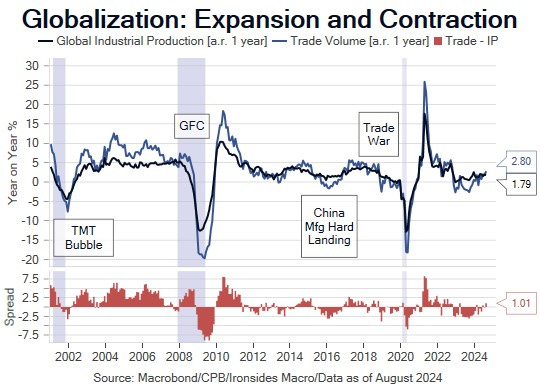Our Dollar, Everyone's Problem
Policy Sequencing & King Dollar, Fiscal Inflation, The Natural Rate Debate, Churn & Productivity
Next week’s note will be delayed until Monday the 25th due to travel conflicts
Dollar Disruption
As we discussed last week in The Threat to Bureaucracy, President-elect Trump is not inheriting a great economy. Excessive monetary policy accommodation in the part of the interest rate curve that should be set by markets, not elite central bank technocrats, and a tightening cycle that left much of the accommodation intact for high quality fixed rates creditors combined with excessively restrictive policy for floating rate borrowers has weakened the small banks and businesses foundation of the US economy. The most expansionary fiscal policy in US history has further exacerbated capital misallocation. The weak foundation was evident in 3Q earnings, ex-technology & communication services (Gen AI beneficiaries) earnings grew 3.9% on 4.1% sales growth, only a modest acceleration is expected in 4Q for the non-Gen AI sectors to 6.4% on 3.1% revenue growth. The outlook for small cap earnings is far worse, since early October 1-year forward expected earnings growth for the Russell 2000 has slipped from -10.5% to -14.9%. Little wonder that after a sharp relief rally, small caps turned sharply lower this week. Tax policy can help, but monetary policy is a larger near term issue for smaller companies. It is important to note that 3Q was the first quarter where the base of the annualized growth rate was not part of the three quarters (4Q22-2Q23) earnings recession. There is a case for reacceleration of earnings growth in ‘25, a rebound in capital investment, strong productivity growth, more favorable tax policy for companies with large domestic revenues and high capital investment, easier regulatory policy, however, the sectors with the best fundamental momentum are historically expensive.
While we expect the incoming Trump Administration to avoid their 2017 tactical approach of getting bogged down with Obamacare repeal & replace that delayed the Tax Cuts & Jobs Act for a year, if the budget process is delayed and the administration focuses on trade policy for the first few months the market reaction is likely to be unfavorable. The continuing resolution that is funding the government expires on Dec 20th, an extension the CR until early ‘25 that forces tax policy to be the first legislative agenda item, perhaps even making changes retroactive to January 1, would a positive outcome for the equity market. The small business sector could be a beneficiary if there is a lower tax rate for domestic producers, however, the October NIFB Small Business Survey characterized financing rates as follows: “The average rate paid on short maturity loans was 9.7 percent, down 0.4 of a point from September’s highest reading since February 2001.” In short, even if our assessment of r**, the financial instability rate, near 4% is correct, and small banks are able to increase the supply of credit in ‘25, the cost of capital for small businesses will remain elevated if the FOMC pauses near 4%. An FOMC that apparently believes they can meander towards the neutral policy could leave the opaque small business sector in a quandary. Finally, if the Byrd Rule balanced budget provision budget reconciliation leads to tax cuts financed by reductions in spending, the bond vigilantes could be kept at bay. An omnibus spending bill that pushes the budget negotiations until later in the year will be negative for the economy, equities and fixed income, if only tactically. The bond vigilantes are still lurking in the shadows waiting for policy mistakes.
While there is a path to improved fiscal policy, and marginally less restrictive monetary policy for floating rate borrowers, there remains a global wildcard, king dollar. At present most expect trade policy is to the first order of economic policy business, the President-elect has not announced his economic or trade policy team, however, unlike the first Trump Administration trade policy actions will precede tax policy. We view left-leaning prostrations about the Smoot Hawley Tariff Act to be overwrought, we were the world’s largest trade surplus nation in 1929, the opposite is true today. That said, the last trade war offset the Tax Cuts & Jobs Act positive business confidence shock and led to a global manufacturing recession. This time around, the world is already in a global manufacturing recession and even with plenty of warnings, including persistent slowing of global trade growth, there has been no efforts by export dependent nations to stimulate domestic demand. For those interested in a deeper dive into the dynamics of global current and capital accounts we suggest reading Stephen Miran’s “A User’s Guide to Restructuring the Global Trading System”. We agree with Miran’s analysis concluding price insensitive sovereign wealth fund and foreign central banks of export dependent economies contributed to dollar overvaluation. His work is consistent with Mike Pettis, “Trade Wars are Class Wars”, conclusion that the US is generally not running a massive trade surplus because of excess consumption by US households, instead export policies of the world’s mercantilists, China in particular, are the primary cause.
In this week’s note we will review inflation week and the implications for monetary policy, delve the post-meeting FOMC participant speeches, delve into the takeaways from earnings season and update our markets outlook.



